Inside the Race to Build a $1.2 Billion Fish Barricade
Over the past 50-some years, invasive carp, a stunningly destructive invasive species, have infested almost every waterway in the Midwest, from South Dakota to beyond the Mississippi Delta, and have even reached West Virginia. In some waters, it’s been reported that around 90 percent of the fish are invasive carp; in one section of the Illinois River, a Mississippi tributary, they make up more than 75 percent of the total biomass in the water. They are obnoxious invaders, overwhelming other fish species, muddying clear waters, and — in some cases — jumping out of the water when startled. A passing boat can throw hundreds of fish into a frenzy, creating an airborne blizzard of 25-pound lunkers that have broken the arms and jaws of recreational boaters.
So far, however, the prolific fish have mostly stopped short of the Great Lakes, blocked by the subtle ridge of a continental divide that circles the lakes’ southern and western shores. Water to the west and south of the ridge flows to the Mississippi River and the Gulf of Mexico. Water to the east and north flows to the Great Lakes, which contain about 20 percent of the world’s surface fresh water and attract boating, fishing, and other recreation, which all together have been estimated to generate between $14 and $42 billion a year.
But the fish, formerly called Asian carp, could still find a way in. There is a single year-round connection between those two main watersheds of eastern North America: the Chicago Sanitary and Ship Canal.
The canal opened to commercial shipping in 1900, and an extension was built seven years later; among the unintended consequences was the creation of a route for invasive species like the carp to move into vast new territories. It connects Lake Michigan and the Chicago River to the Des Plaines River, which pours into the Illinois River, which is lousy with invasive carp.
At the Brandon Road Lock and Dam, south of Joliet, Illinois, below where the canal and Des Plaines River meet, there is a choke point, a 110-foot wide channel and lock through which the carp must pass to get to the Great Lakes. There, the Army Corps of Engineers is mustering about $1.2 billion taxpayer dollars to build a barrier that will, hypothetically, stop the carp from getting to the lakes.

Experts say that keeping the fish out is worth the price. “It would be a cataclysmic event,” said Greg McClinchey, legislative affairs and policy director of the Great Lakes Fishery Commission, contemplating the arrival of invasive carp in the lakes. “As expensive as any project might be, the cost of failure is much higher.” (The commission is also working with partners in Ohio to control invasive grass carp that have established a small breeding population in the Lake Erie watershed, but these fish are not as big of a threat as other invasive carp species.)
What is officially called the Brandon Road Interbasin Project is, in effect, the Great Lakes’ last line of defense. It will be a gauntlet of barriers that will take years to install and use a variety of technologies, from electric shocks to curtains of bubbles, to inflict sufficient discomfort on the advancing carp that they may turn around and leave the Great Lakes alone.
“I have great hope that the technologies will work,” said Molly Flanagan, chief operating officer of the nonprofit Alliance for the Great Lakes. “One open question is whether we can build them fast enough.”
There are four types of invasive carp: bighead, silver, grass, and black. Although the exact date of the invasive carp’s introduction is unclear, the fish were deliberately introduced into the United States, possibly in the early 1960s, first as a sport fish and then, improbably, as the solution to an environmental problem: the heavy use of herbicides to clear weeds from catfish farms in the Mississippi Delta. The bottom feeding carp would root up weeds and consume floating algae.
“The understanding was that there was no way these fish could reproduce in this environment,” said Brian Schoenung, the aquatic nuisance species program manager for the Illinois Department of Natural Resources. “It was a great way to cut back the chemicals.”
In the early 1970s, flooding liberated thousands of the imported carp from the catfish ponds, washing them into tributaries of the Mississippi. It turns out that they reproduced in American waters just fine, and they soon wreaked havoc on the waterways and native species. “It is the pig of the fish world,” wrote outdoor writer Mark C. Dilts of the carp, “rooting around in a weed bed, which it will eventually destroy as habitat for other fish. Its plowing around on bottom muddies the water so sunlight cannot penetrate to stimulate future plant growth.”
When startled, silver carp jump out of the water — the only of the four species under the umbrella of invasive carp to do so. A passing boat can create an airborne blizzard of 25-pound lunkers that have broken the arms and jaws of recreational boaters.
Visual: BootprintsTV/YouTube
Before the passage of the federal Clean Water Act in 1972, transit of invasive species through the Chicago Sanitary and Ship Canal wasn’t an issue. The roughly 30-mile passage — which, when it was built, reversed the flow of the Chicago River so the city’s sewage would flow south rather than out into the city’s drinking water in Lake Michigan — was so polluted fish couldn’t survive in it. But the act, more or less, cleaned up American waterways and lowered pollution in the canal sufficiently that a few hardy species started to appear.
Among the fish moving into the canal was the round goby, an aggressive and voracious Eurasian native that came to the Great Lakes in the bilgewater — water pumped out of a ship’s hull — of oceangoing freighters.
Looking for a way to keep the round goby from spreading into the Mississippi River basin, experts considered dozens of possible solutions, including the introduction of “biological pathogens” into the ecosystem, using superheated water from power plants to make the fish uncomfortable, poisoning the waterways, and just plain shutting the canal down. In 1996, Congresss authorized the Army Corps to develop a fish barrier, and the Corps’ advisory panel settled on building something reminiscent of the invisible fences that contain dogs in backyards: a barrier that would use electrical pulses to convince the fish to turn back.
The Army Corps identified a location near the town of Romeoville, Illinois for the construction of the first barrier. Inconveniently, the goby turned up well downstream of the Romeoville site just as the project started. On the assumption that some variation of the same problem was going to pop up in the future, the project was changed from a deployment aimed at one species to a testbed to see how electric pulses would work on a broader range of fish.
During the study period, scientists tagged and planted 130 common, locally captured carp in the canal. They monitored the carp to see how they reacted to the electrical pulses. (And, by sheer chance, to see how human beings reacted as well. One barge crew, despite warning signs, tried to tie up near the facility using metal cable. The connection threw a 12-inch spark, which could have blown the barge up had it been carrying more volatile cargo.)
Only one fish made it past the electrodes during the test, apparently as a hitchhiker in the space between barges as they pushed up the canal. Also of concern was the fact that the system experienced, as electrical systems often do, periodic outages, the longest of which was 56 hours, long enough to let whole schools of fish through.
When the test ended, observers from the American Fisheries Society, a nonprofit organization for fisheries professionals, concluded, “The electric barrier is at best a partial solution.” While the final report from the operators of the barrier called their work “reliable technology to repel fish without killing them,” it also suggested that further implementation might benefit from the inclusion of other types of deterrents, including air bubbles and sound to repel fish.
For more than 30 years, the Army Corps and its partners have been contemplating and experimenting with different kinds of barriers to keep invasive carp out of Lake Michigan. During that time, there have been scares. Invasive carp DNA seems ever-present in the canal and even in the lake itself, and has so far been traced to benign sources. But more recently, in August 2022, a fisherman reported a silver carp in Lake Calumet on the upstream side of Brandon Road Lock and Dam, only seven miles from Lake Michigan. The nightmare was that the carp had, like the round goby before it, bypassed the barrier being built to stop it.
In response, government agents launched a fleet of small boats in search of the carp — which they caught — and to see if there were others. After a couple of weeks and no additional carp found, everyone heaved a sigh of relief.
“Every time that happens, I think it’s like a siren going off to remind us we’re at risk,” said Flanagan. “We shouldn’t ignore it when we find a single fish,” she added.“Every time we should pay attention and know that we need to get these protections in place.”
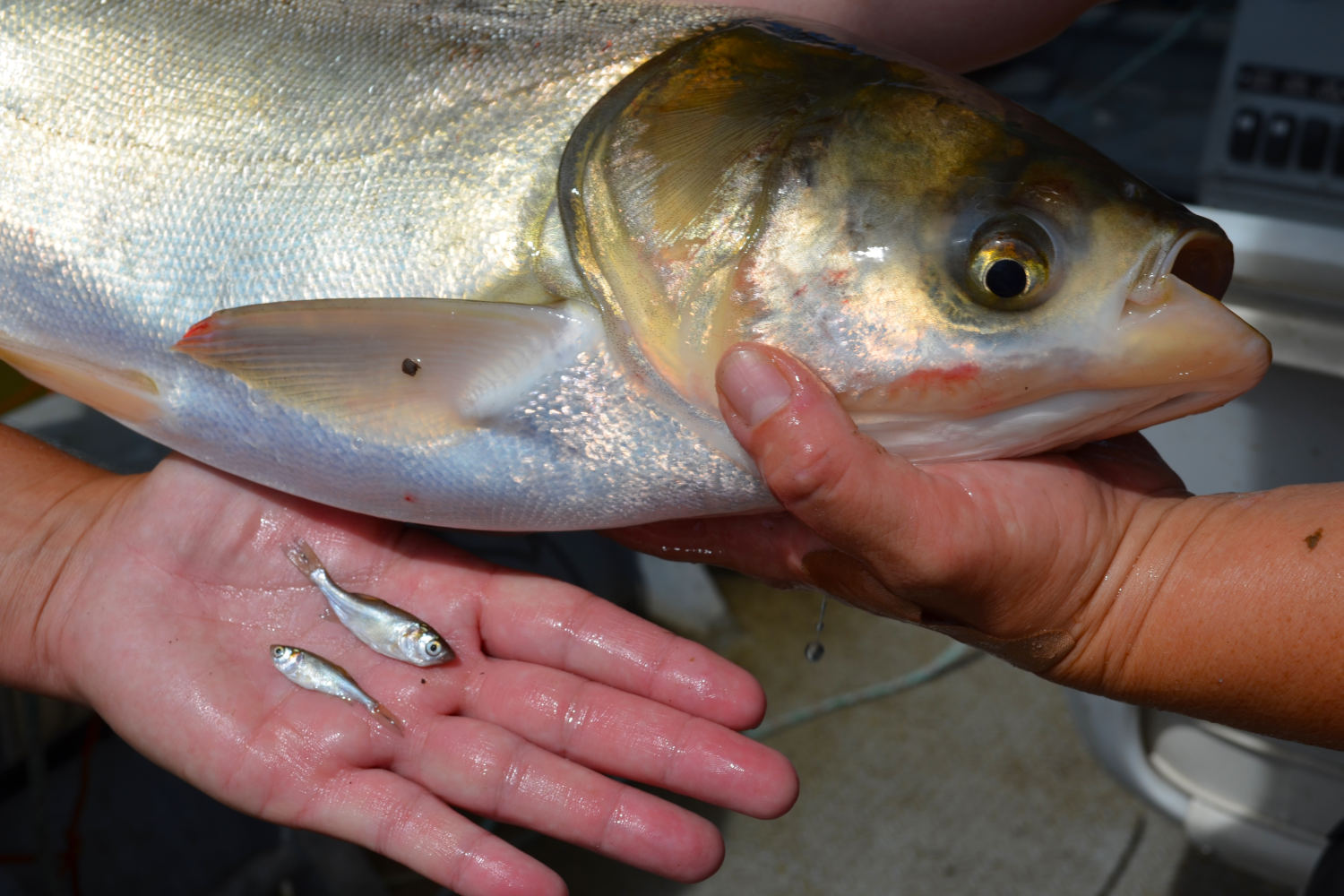
Soon after that scare, Illinois and Michigan inserted items into their proposed state budgets that will pour $114 million into Brandon Road, covering the local match necessary to start the next tranche of federal funds flowing. (The funds from Illinois were recently signed into law, while those from Michigan have yet to be appropriated.) The barrier, previously conceived as a $778 million project, has ballooned to roughly $1.2 billion.
As the project is currently envisioned, a fish moving upstream will have to negotiate a half-mile-long series of obstacles. Each of the obstacles is intended to turn back the vast majority of carp so that the number of carp diminishes to near zero as fish push upstream. If any reach the open water above the lock, the researchers believe, there will not be enough to find each other, let alone establish a breeding population. The multiple lines of defense also provide layers of redundancy in case one of the systems malfunctions.
“There’s not one silver bullet that stops all fish,” said Mark Cornish, a senior technical specialist and biologist for the Army Corps, which is especially true when the waterway also has to remain open to boats and other vessels.
Near the downstream entrance to the lock’s main channel, fish will encounter what Army Corps senior researcher Christa Woodley called “the first line of defense.” It is a combination of the barrier types recommended after the experimental installation at Romeoville: a thick curtain of air bubbles and an array of underwater speakers that blast noises at frequencies and volumes that drive invasive carp away.
“We’re learning we’re effective. We’ve learned we have very little impact on native species, which is wonderful,” she said. “We play different patterns and frequencies all mimicking things that are in the environment and that we’ve seen affect them.”
Working on a test array in the Mississippi River near Keokuk, Iowa, Woodley and her team have tagged thousands of fish and monitored their movements around the barrier’s underwater speakers. She estimated that the acoustic deterrents drive back 99.5 percent of invasive carp, and that further tweaks could eventually increase that to 99.9 percent.
With thousands of fish in the river, it means a few will get through. Those carp will find themselves in a reengineered channel. For several hundred yards it will be, basically, a concrete box free of anything like fish habitat. There will be no outcrops behind which fish can rest against the river’s current, no food sources, and — from the fish’s point of view — nothing enticing them forward.
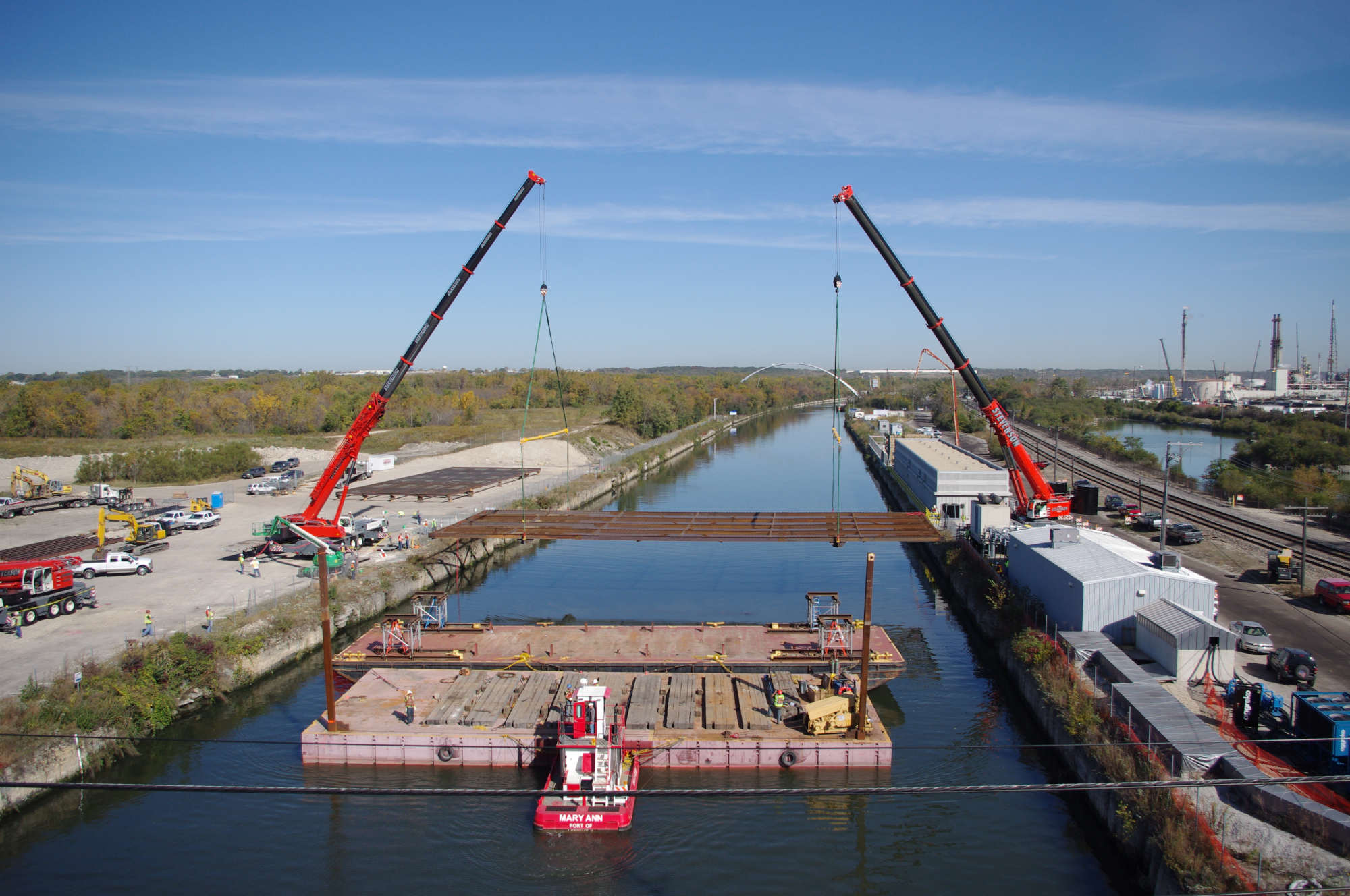

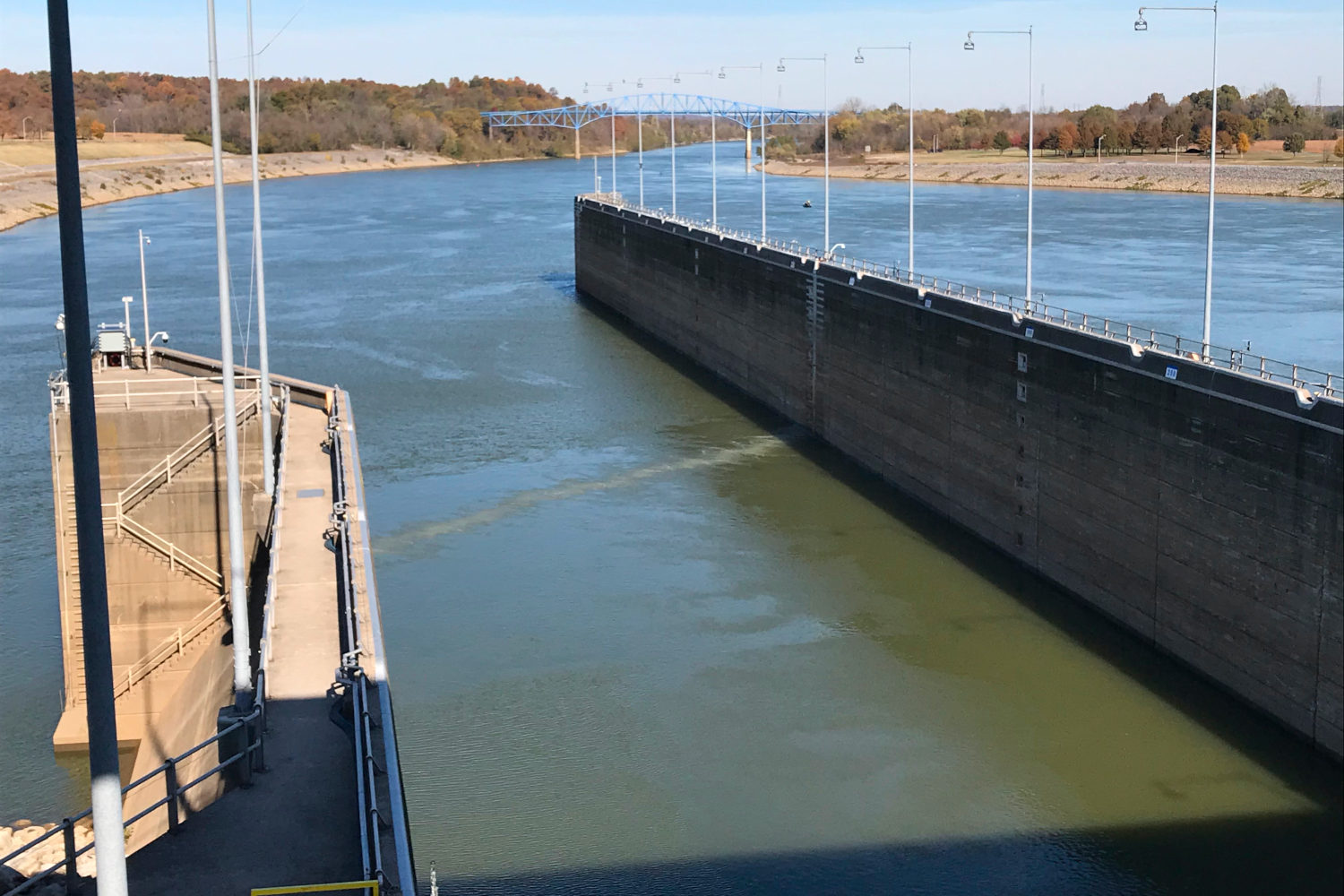
Nonetheless, there will inevitably be a few fish adventurers who press on, and just before they reach the lock itself they will encounter an electric deterrent much like the one tested at Romeoville. It will cause approaching fish to tingle unpleasantly and, if they push farther into the electrode array, be stunned so they can’t swim against the current. Those fish will, theoretically, be carried back downstream.
On the off chance that a few fish make it through all of that and into the lock itself, there is a second, larger acoustic array. And if any fish try to hitchhike in the space between the barges like the one rogue carp did during the Romeoville test, the lock itself is being reengineered as what is called a “flushing lock” that physically pushes even the tiniest organisms back downstream.
The lock currently “creates turbulent flows,” said Cornish. “If you were a floating organism, it would swirl you around, but wouldn’t necessarily push you out of the lock. The flushing lock moves things out of the lock” and back downstream.
And if, after all of that, some fish continues to fight its way against the canal current toward Lake Michigan, it will run into the electric array at Romeoville 10 miles from Brandon Road Lock and Dam — a long swim for a tired fish.
As important as the barriers are, Schoenung emphasizes the impact of what he calls “non-structural components,” which is what he calls the anti-carp activities that are currently taking place.
“Barriers are useful, but in conjunction with other things,” said Schoenung. “I don’t think we can discount the non-structural work that goes on and keeping the reproductive front downstream, because I don’t know that you can design a barrier that would prevent all classes of carp from getting through.”
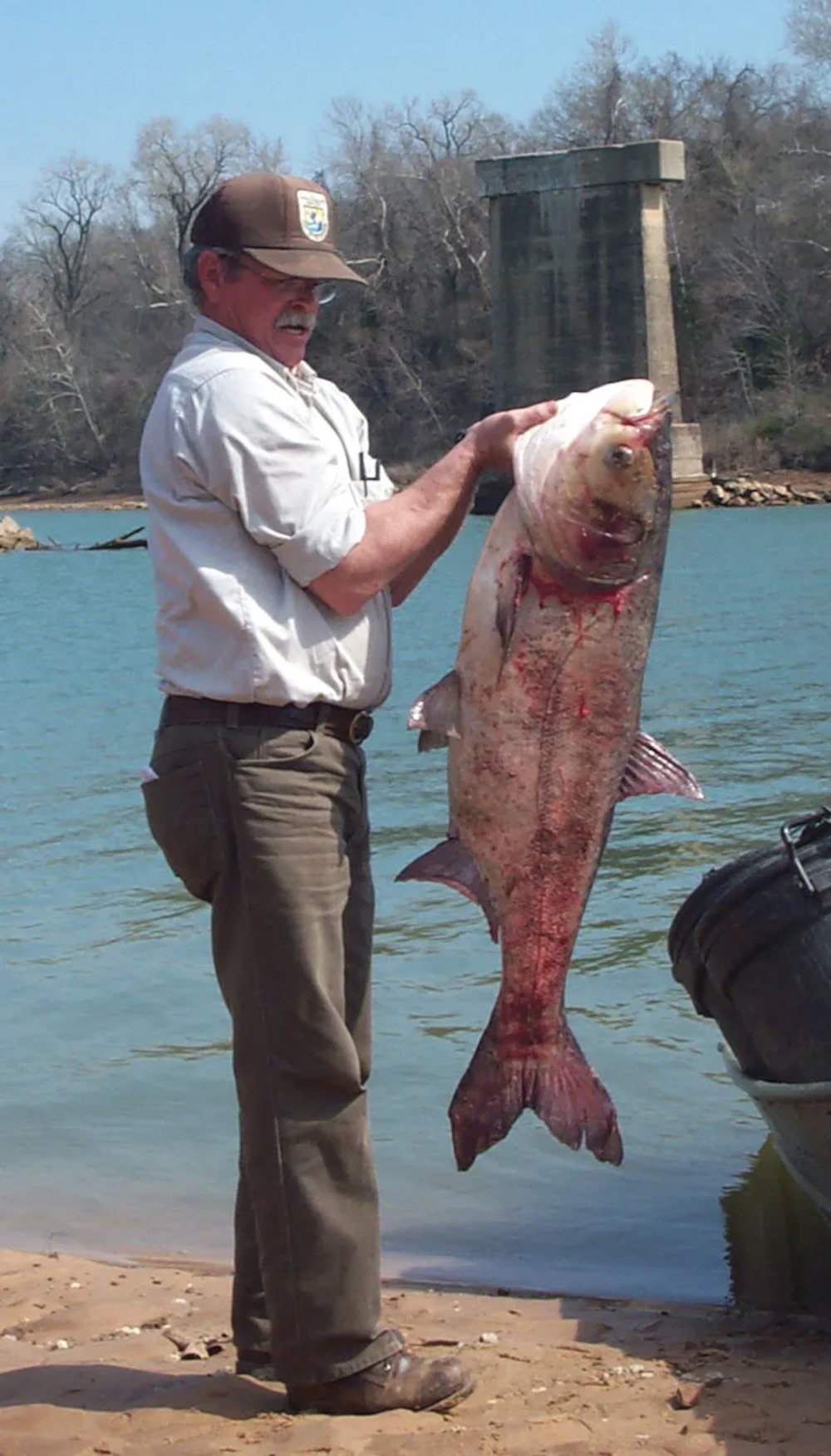
There are four types of invasive carp: bighead, silver, grass, and black. In this photo, a U.S. wildlife-management official holds bighead carp, which can weight up to 110 pounds.
Visual: USFWS
Law enforcement monitors boat ramps to make sure people comply with rules banning the movement of live fish from one place to another, either deliberately or accidentally. A significant public education campaign has raised awareness of the carp.
But the most striking non-structural activity is catching carp. Up and down the Mississippi and its tributaries, carp are being pulled out of the water at a fantastic rate. In Kentucky, for example, more than 9 million pounds of carp were harvested in both 2021 and 2022. On the Illinois River downstream from Brandon Road Lock, 10 million pounds have been harvested since 2019, said Schoenung.
The Illinois Department of Natural Resources has built a marketing campaign around eating invasive carp, which is popular across Asia, in hopes that consumer demand will increase commercial fishing, even rebranding the fish as “copi” (a play on the word “copious”) as part of the effort.
“We’re having some measurable impact with our commercial harvest program to suppress those numbers a bit. It’s hard to quantify,” said Schoenung. “There’s a huge number of variables to take into account, and you have to ask are we better off allocating resources to remove fish, or studying the impact of removing fish? There’s not enough money to do both.”
The effect of all that activity is to reduce population pressure for the carp to seek new habitat, which is important because, according to the current plan, actual construction on the project doesn’t begin until October 2024, and won’t be complete until July 2029.
“We want to protect the Great Lakes as quickly as we possibly can. We try to implement the most easily constructed things as fast as we can,” said Cornish. “We want to get those things that have a likelihood of happening and working installed quickly, and work on the others. That buys us a little wiggle room.”
The first phase, the installation of the bubble curtain and narrow acoustic array at the downstream entrance to the channel, will theoretically be completed in late 2026. Phase 2 will bring online the enlarged electric array and the second acoustic barrier, along with the reengineering of the lock so that it flushes fish downstream as barges pass. The final phase, which includes rebuilding the channel so it is inhospitable to passing fish, will require the temporary shutdown of barge traffic, and perhaps some blasting of bedrock to make room for improved deterrent systems. If all goes according to plan, construction will be complete in mid-summer of 2029.
Today, invasive carp are regularly captured one dam downriver from Brandon Road, about 15 miles away. That is not thought to be a breeding population, however. The nearest confirmed breeding population is 55 miles downstream at Starved Rock Lock and Dam.
The advance of the carp seems to have slowed. “A little bit of creep” is how Schoenung described the carp’s current movement. Schoenung attributed that to the non-structural efforts being made all over the Mississippi Basin. And the game, for now, is to buy time while the Army Corps builds its barriers.
Then hope the whole thing works.
Tom Johnson writes about technology, business, and whiskey in Louisville, Kentucky. He has written or co-written dozens of historical and military documentaries, and been published in Los Angeles, Newsday, Vineyard & Winery Management, Bourbon+, and other publications.










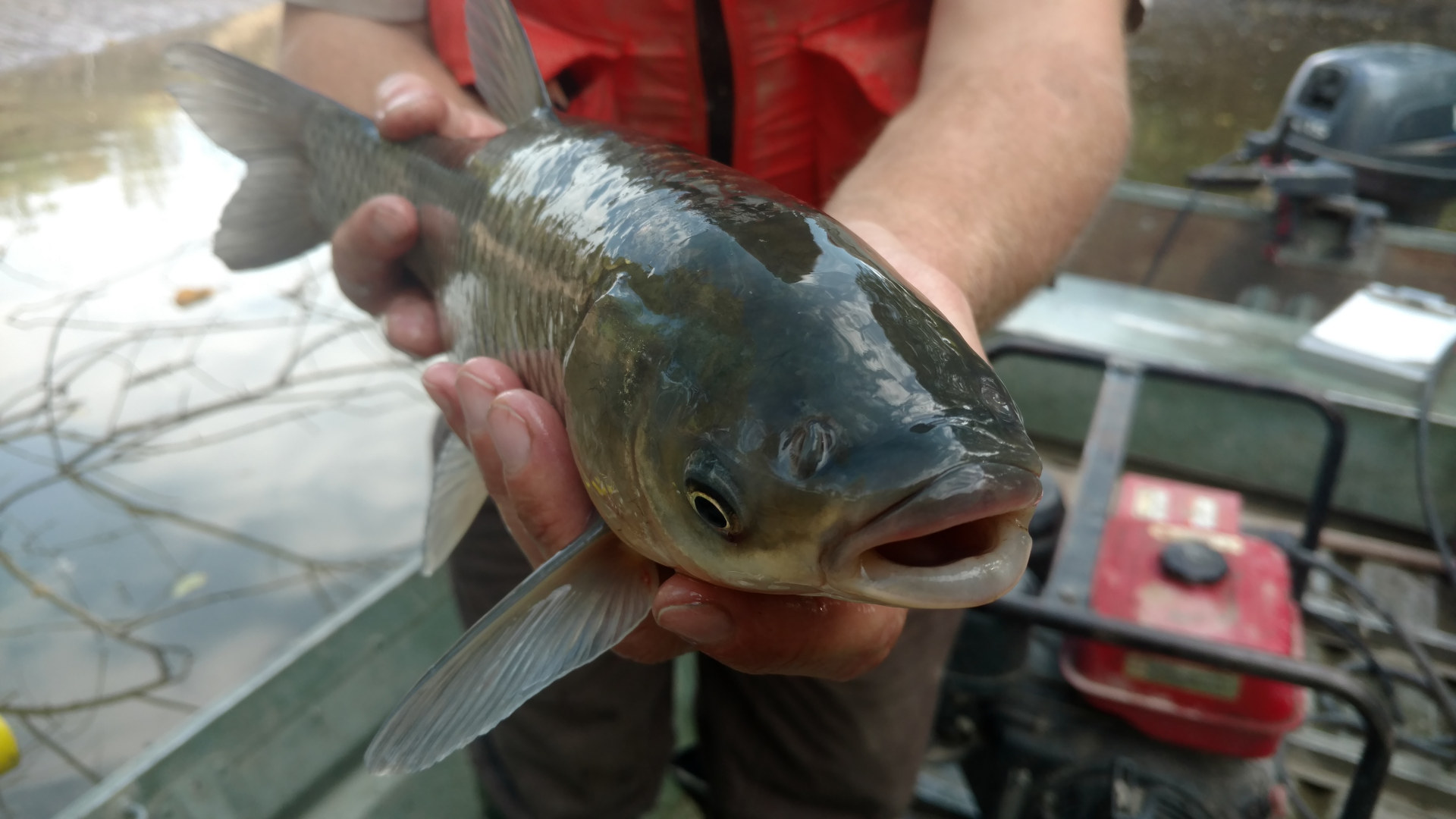
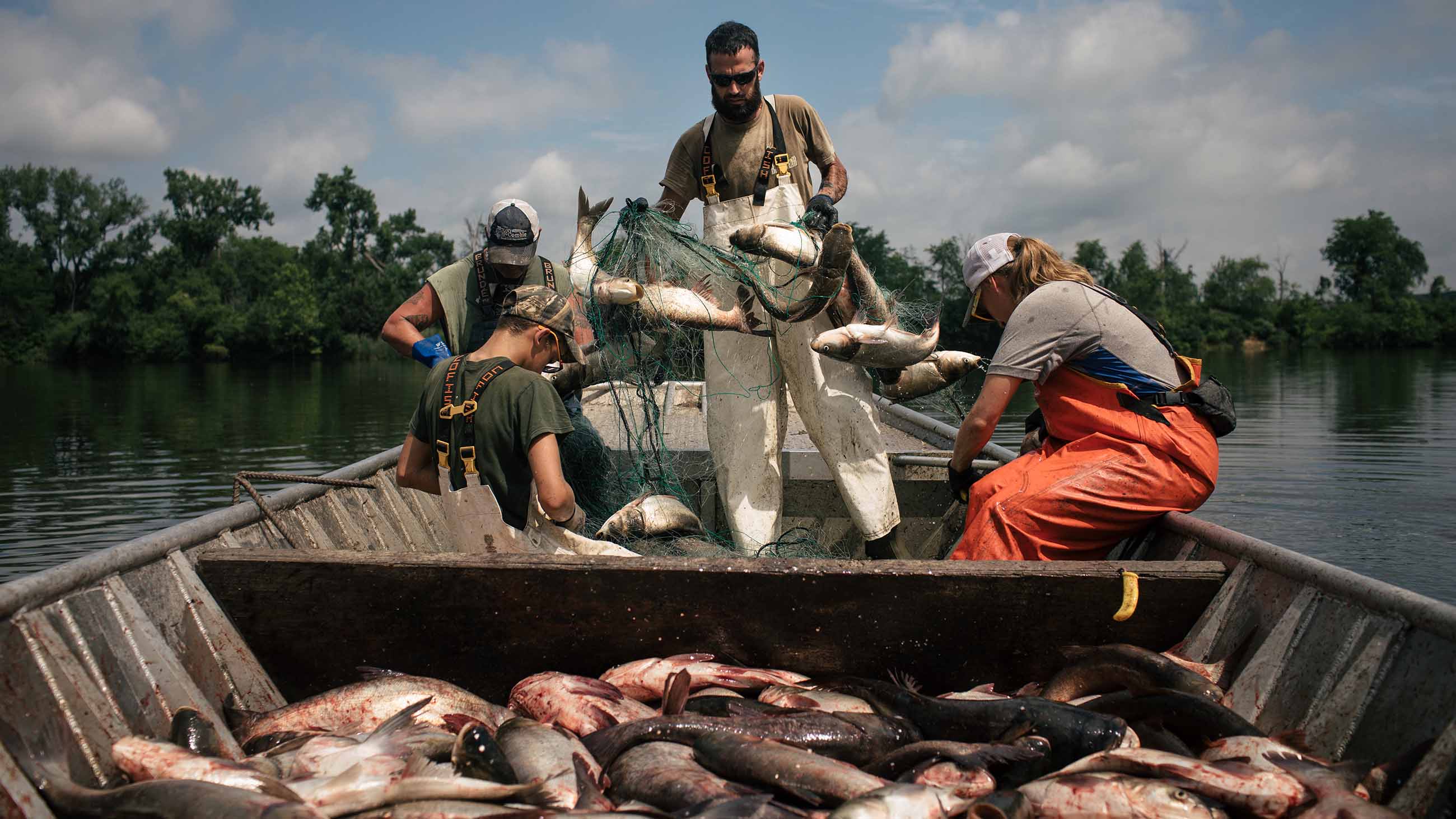
Comments are automatically closed one year after article publication. Archived comments are below.
Eat them. https://wildlifemanagement.institute/outdoor-news-bulletin/august-2022/if-you-cant-beat-em-eat-em-illinois-rebrands-invasive-asian-carp#
Brandon Lock demonstrates the incompetence of the Invasive Carp Regional Coordinating Committee (ICRCC). For under $50 million a bubble acoustical light barrier at Starved Rock dam would be more effective moving the leading edge of invasive carp 55 miles further from Lake Michigan. Since above Starved Rock the carp do not reproduce, harvesting is effective. The 75% bio-mass is due to IL DNR supporting and for the last few years ICRCC supporting and subsidizing commercial harvesting. Unless 83+% of the carp are removed every year, the carp overcompensate and the invasive carp population increases as does the carp bio-density. The carp more likely to immigrate to new rives and lakes. Why is teh ICRCC so incompentatent and insiting on their technology and not solving the problem: GREED. The goal is not to turn the 20+ year $1.5 billion program into a 30 year $2.5 to $3 billlion program, it is to keep the silver carp out of the Great lakes and control their population in the Mississippi Basin. What was a $178, then $218, and then $858, is now $1,200 million barrier. Invasive carp are not the only nuisance species in the United States. T4he real damage of ICRCC is the committee is why try for the next invasive species? What the data, email me.
The fishes don’t know where they are. They aren’t trying to get anywhere in particular. They don’t know there are lakes upstream. They certainly don’t know they’re “Asian” and none of them ever have been, individually. They don’t know and don’t care about the expectations of people in fast boats.
Big fish start life small, and it’s abundantly obvious that no system of barriers will (or has) prevent someone with a bucket from moving them as “minnows” to the next watershed, and the next after that, etc. In immediately practical terms, as long as they end up in suitable habitat, they’re where they “belong.” The nativist-industrial complex doesn’t stand a chance— and it might not even be entirely in their interest to succeed. Not much of a business model to put yourself out of work. Not much of an academic or bureaucratic one, either.
Whether it was a bad idea to move these animals from one continent to another in the first place is pretty much a moot point now.
Grass carp can cause major damage.
Provide dumpsters and make it legal and fun to kill these carp w bow and arrows, spears, or hook and line. Try a bounty